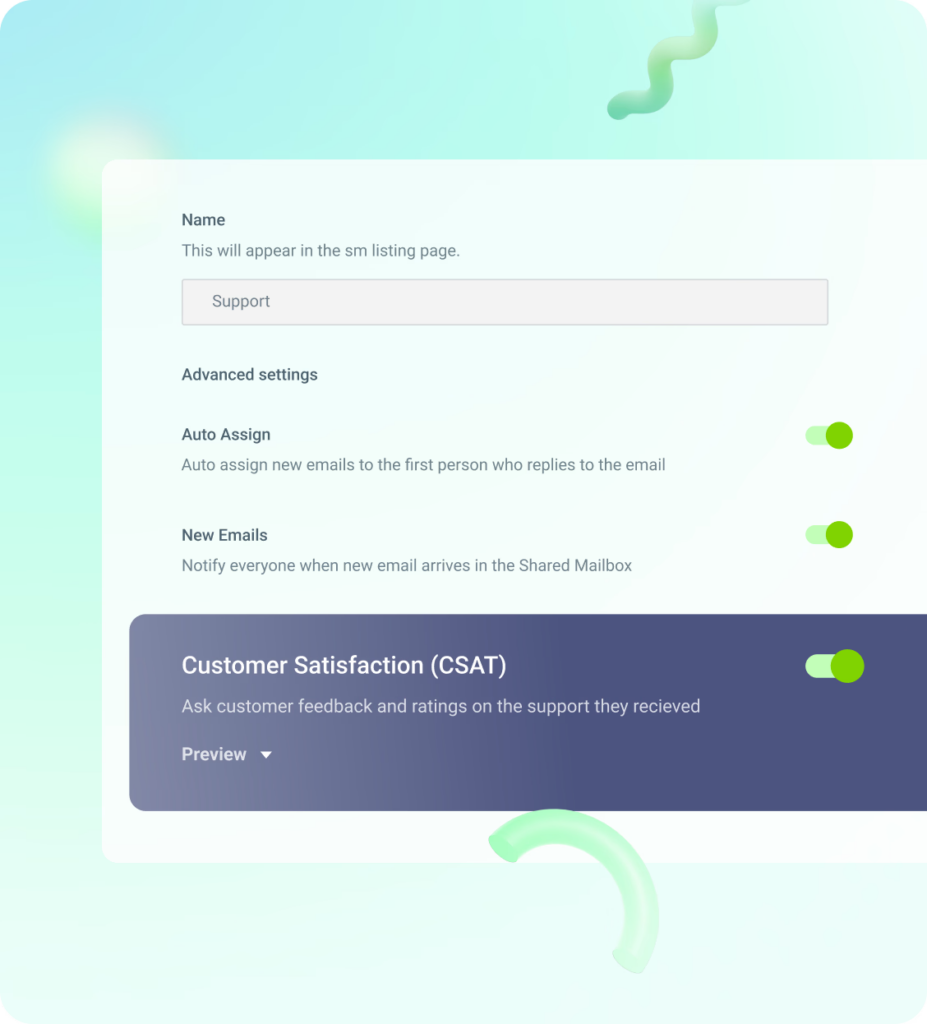7 Actionable Tips To Improve Customer Focus

Table of contents
Imagine walking into your local bookstore. The owner greets you by name, asks about the last book you bought, and recommends a new release in the same genre. This experience is what makes you go back to this bookstore over and over again.
This isn’t just good service; it’s excellent customer focus.
It’s about recognizing and valuing each customer as an individual, understanding their preferences, and going the extra mile to meet their needs.
Customer focus is the backbone of any successful business strategy. It goes beyond seeing customers as mere transactions. It’s about building meaningful, lasting relationships with them. It’s about listening, learning, and evolving to meet changing customer needs and expectations.
So, how can businesses cultivate this level of attention and care? Here, we will explore 7 actionable tips that can significantly enhance your approach to customer focus, enabling you to create more personalized, enriching experiences for your customers.
But first, let’s understand customer focus better:
Table of Contents
- What is Customer Focus?
- Benefits of High Customer Focus
- 7 Actionable Tips to Improve Customer Focus
- How to Keep Your Organization Customer Focused?
What is Customer Focus?
Customer focus is the commitment a business makes to prioritize the needs, preferences, and feedback of its customers. It’s not just about providing a product or service; it’s about creating an experience that resonates with the customer.
A customer-focused company seeks to understand its customers deeply and tailors its offerings to meet their specific needs.
This approach involves proactive communication and a robust feedback loop to refine and optimize the customer journey continuously. It necessitates a blend of data-driven insights and empathetic engagement to address customer concerns and enhance overall satisfaction effectively. In essence, it’s about cultivating a deep, enduring relationship that fosters loyalty and turns customers into advocates.
Benefits of High Customer Focus
What differentiates one brand from another is the experience they offer. Companies like Apple and Amazon have set the bar high, showing that when you prioritize the customer’s needs and desires, you not only gain their loyalty but also turn them into brand ambassadors.
Here are some benefits of how high customer focus helps your business:
1. Enhanced Customer Satisfaction: Meeting and exceeding customer expectations leads to higher levels of satisfaction, fostering a positive association with the brand.
2. Increased Customer Loyalty: Satisfied customers are more likely to be loyal and make repeat purchases, contributing to a stable customer base.
3. Positive Word-of-Mouth: Happy customers are more likely to recommend a business to their friends and family, extending the company’s reach and influence.
4. Improved Brand Reputation: Consistently meeting customer needs enhances the overall perception of the brand, establishing it as trustworthy and reliable.
5. Higher Revenue and Profitability: Loyal customers tend to buy more and are often willing to pay a premium for superior service, directly impacting the bottom line.
6. Better Customer Retention: Focused customer service and personalized experiences reduce the likelihood of customer churn, safeguarding revenue streams.
7. Enhanced Competitive Advantage: Business strategies that prioritize customer needs can differentiate themselves from competitors, attracting more customers through distinct value propositions.
8. Increased Employee Satisfaction: A customer-centric culture can lead to higher morale and job satisfaction among employees, promoting a positive and productive work environment.
9. Greater Business Sustainability: Building long-term relationships with customers contributes to ongoing business success and resilience in fluctuating market conditions.
10. Informed Business Decisions: Understanding customer needs and preferences leads to more effective product development and marketing strategies, aligning offerings with market demand.
11. Reduced Negative Feedback: Addressing customer concerns proactively can mitigate negative reviews and feedback, preserving the integrity of the brand image.
12. Optimized Resource Allocation: Focusing on what customers value most allows businesses to allocate resources more efficiently, maximizing impact and minimizing waste.
13. Agility and Innovation: Continuous feedback from customers can drive innovation and help businesses adapt to changing market conditions, ensuring relevance and sustainability.
7 Actionable Tips to Improve Customer Focus
If you’re looking to improve your customer focus to deliver truly outstanding experiences, here are 7 tips that can help:
1. Listen Actively to your customers
Listening isn’t just about hearing; it’s about understanding what is being said. Engage with your customers on social media, surveys, and feedback forms. When customers feel heard, they feel valued.
To enhance this, consider implementing regular “Voice of the Customer” sessions to address feedback and concerns directly. Utilize customer relationship management (CRM) systems to track interactions and feedback. Respond to comments and online reviews promptly and constructively, and make visible improvements based on the feedback received.
This proactive approach not only resolves individual concerns but also demonstrates a company-wide commitment to meeting and exceeding customer expectations.
💡Take the case of Starbucks. They launched “My Starbucks Idea,” a platform where customers could share their ideas and feedback. This initiative led to the introduction of many new products and services based on customer suggestions for a decade.
2. Personalize the Customer Experience
Think of a tailor who crafts a suit just for you, fitting every contour of your body. That’s what personalization in business feels like to a customer.
Use data analytics to understand customer preferences and tailor your offerings. Companies like Netflix use algorithms to suggest shows based on viewing history, enhancing the user experience.
To deliver personalized customer service, implement email campaigns addressing customers by name and referencing past interactions or purchases. Develop user profiles to deliver targeted content and offers and employ A/B testing to refine personalization strategies based on customer responses.
These steps ensure a more individualized and engaging customer interaction, fostering loyalty and satisfaction.
3. Empower Your Employees
Train your employees to understand and prioritize customer needs. When they have the tools and authority to make decisions, they can better serve the customer.
To do this, establish clear guidelines for employee empowerment, allowing them to resolve customer issues promptly. Encourage open communication channels for employees to share insights and feedback about customer interactions. Additionally, consider implementing a digital badge system to recognize and celebrate employees who consistently excel in delivering exceptional customer service, fostering a culture of continuous improvement and recognition.
Regularly update training programs to include the latest customer service best practices and ensure that employees have access to the necessary resources to effectively address customer needs.
💡One of the most renowned hotel chains in the world, Ritz Carlton, stands out for its excellent customer focus. Ritz-Carlton empowers its employees with a discretionary budget to solve guest issues without needing managerial approval. This leads to quicker resolutions and happier customers.
4. Stay Ahead of the Curve
Being proactive rather than reactive can set you apart. Apple, for instance, doesn’t just respond to current market needs; they anticipate future desires, leading to innovative products like the iPhone.
Invest in research and development, and always keep an ear to the ground. Understand emerging trends and adapt accordingly.
To improve your customer focus to be more proactive, conduct regular market analysis to identify upcoming industry shifts and consumer preferences. Engage with thought leaders and attend industry conferences to gain insights into future trends.
Develop a robust feedback loop with customers to understand their evolving needs and expectations. By doing so, you can refine your product development strategies and position your offerings effectively to meet the demands of the future market landscape.
Recommended read:
Research shows 44% support experts believe AI can predict can customer needs. Learn how
5. Seek Feedback and Act on It
Regularly solicit feedback and, more importantly, show customers that their input leads to tangible changes.
To implement this, deploy customer satisfaction (CSAT) surveys post-interaction and encourage online reviews. Establish a system to analyze this feedback for common themes and areas for improvement.
With customer service platforms like Hiver, add CSAT surveys to customer interactions and analyze scores via detailed reports.

Acknowledge the received feedback and communicate the implemented changes to your customer base, demonstrating a transparent and responsive approach to customer opinions and concerns. This not only builds trust but also enhances your brand’s credibility and reliability in the eyes of the customers.
For instance, many software companies release beta versions of their products to a select group of users. They gather feedback, make necessary adjustments, and then launch a refined final product. This helps them build something that aligns exactly with what their customers want.
6. Build Trust Through Transparency
Build trust through transparency: Be open about your business practices, admit mistakes, and communicate how you’re addressing them. Companies like Patagonia have built a loyal customer base through their commitment to transparency and ethical practices. For instance, Patagonia’s The Footprint Chronicles provides clear information about the every products’ environmental impact throughout its lifecycle.
To do this, regularly update customers on internal developments and decision-making processes through newsletters or blog posts. Create a dedicated knowledge base or transparency page on your website detailing your business practices, sourcing, and ethical standards.

You can also engage in open dialogues on social media platforms to address customer queries and concerns directly and promptly disclose any issues or setbacks, along with the steps being taken to resolve them. This proactive approach to maintaining transparency can significantly bolster customer trust.
7. Foster a Customer-Centric Culture
It’s not just the customer service department that should focus on customers. Every department, from product development to marketing, should have the customer at the heart of their decisions.
Celebrate customer successes, share feedback with the entire team, and ensure that everyone understands the value of a satisfied customer.
To improve your customer focus on an organizational level, integrate customer-centric goals into performance metrics and KPIs across all departments. Conduct regular cross-functional workshops to discuss customer insights and collaboratively develop strategies to enhance customer experiences.
Encourage every team member to think from a customer’s perspective when making decisions and creating new initiatives. Having a customer service software that enables organization-wide customer focus can help you achieve this.
Hiver enables businesses to improve customer focus with its collaborative features. With features like Notes and @mentions, every team member, irrespective of their department, can collaborate with the support team to help solve queries without wasting any time.

By embedding a customer-centric mindset throughout the organization, businesses can ensure cohesive efforts in delivering superior value and satisfaction to their customers.
How to Keep Your Organization Customer Focused?
Maintaining a customer focus is an ongoing journey, not a destination. It requires continuous effort, adaptation, and a genuine commitment to serving the customer. Encourage open communication within your organization, celebrate customer-centric achievements, and always be willing to learn and adapt.
Remember, in the bustling marketplace of business, companies that truly understand and prioritize their customers are the ones that stand out and thrive.

































